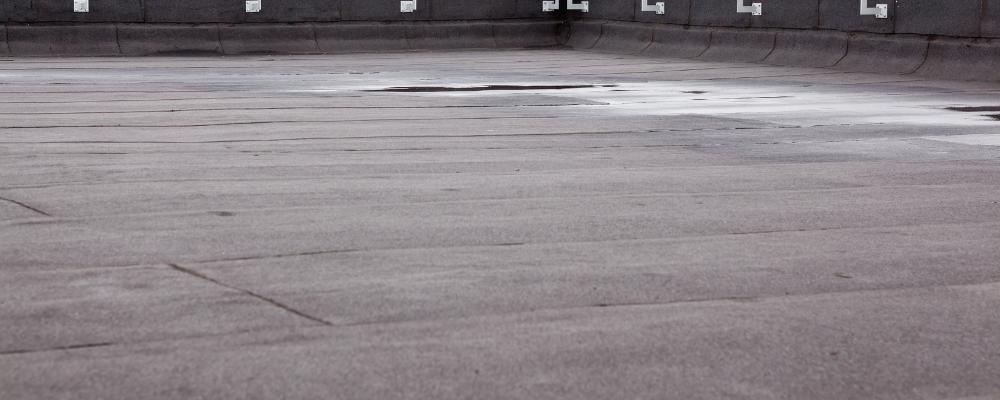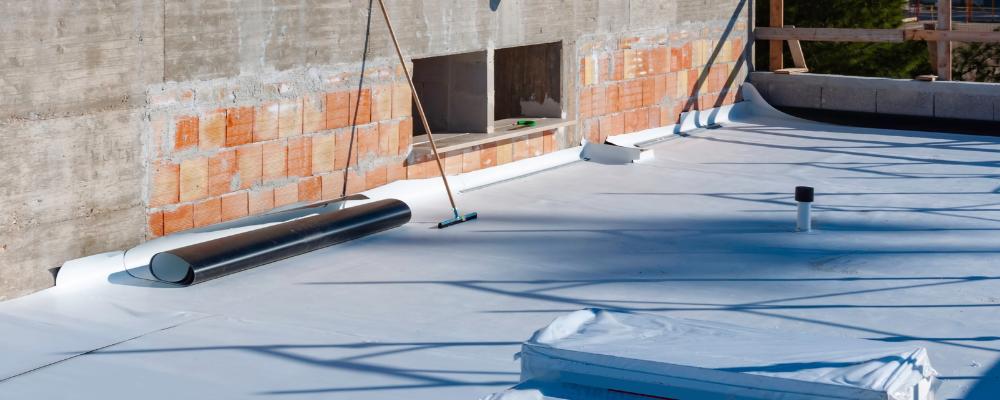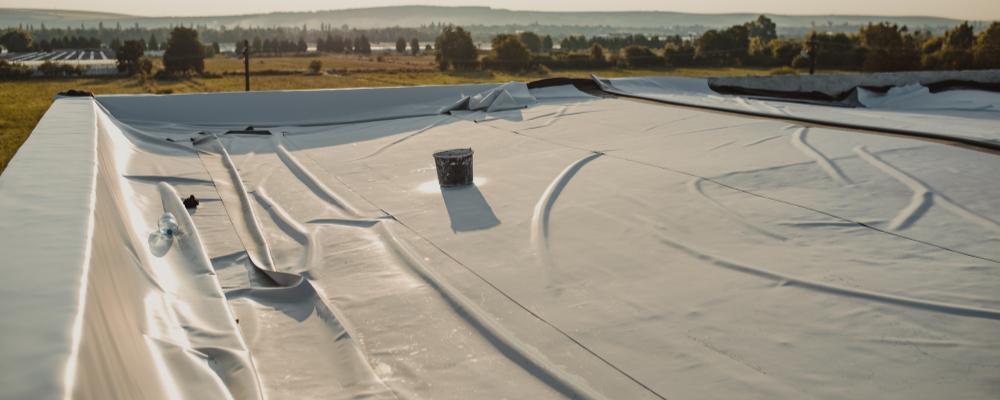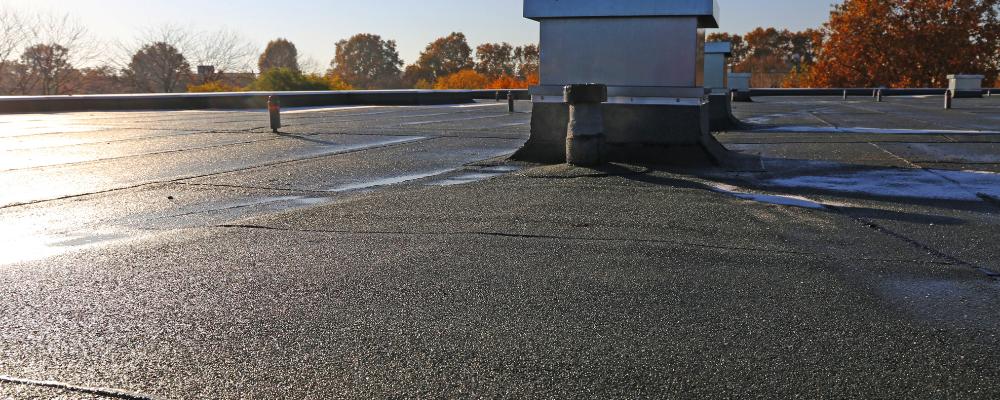Both the top and the base of a building project are equally important, as the absence of even one of them may cause huge impacts at later stages. One of the most neglected things while building or renewing a new house or commercial unit is the choice of material for a flat roof.
Having their own set of pros and cons, all the multitude of flat roof material options makes it a bit hard for individuals to choose one single option from them. Reasons for this include considering factors such as its installation and maintenance costs, its ability to withstand various weather conditions, its durability, and much more.
To remove this off-putting thought from your mind, take help from our guide about the best materials for a flat roof. This curated small list of ours about the top flat roof materials will provide you with significant results, for sure.
Types of Materials Used for a Flat Roof
1. Modified Bitumen

Depicted by its name itself, modified bitumen is made up of multiple layers of membranes that are applied with the help of a blowtorch to come up with a tough and seamless membrane at the end. They are also referred to as the evolutionary cousins of the built-up roofing systems that have been most commonly used on low-slope roofs for years now.
Being made of asphalt primarily, they are much more like three-tab asphalt shingles, but with an additional waterproof coating applied, making them more flexible. Based on the size of the project and budget, different techniques for its installation can be employed, including torch-applied, hot-applied, cold-applied, and self-adhered approaches as well.
Pros:
- It is one of the best choices for a smaller flat roof replacement.
- This kind of material is available in many different colours.
- As compared to other kinds of materials, it is relatively easier to install.
- They are referred to as one of the most ideal choices to be used for commercial roofs because of their flexibility.
Cons:
- At times, they aren’t able to withstand external factors such as fallen branches, hail, or other severe weather patterns.
- They have a typically shorter lifespan, i.e., between 10 and 15 years, that calls for regular maintenance.
- Its installation might call for professional expertise or advice.
2. BUR (built-up roof)

Built from a stack of multiple layers come multiple-ply roofs, generally referred to as built-up roofs (BUR). These layers are assembled and bonded together using asphalt or tar. It’s one of the most commonly used roofing methods and has been used for over a century now. All the layers are either based on reinforcing fabric or bitumen.
For both commercial buildings and residential ones, they come up as the best option as they can offer a continuous sealed surface as they are applied in a continuous manner. Along with the added layers, the gravel or stones put on it add to its lifespan and energy efficiency and also offer excellent UV protection.
Pros:
- They have exceptional durability and water resistance based on their multi-layer structure.
- This kind of flat roof easily absorbs storm damage and various forces of nature, including rain, wind, hail, and other flying debris.
- It also offers good insulation as compared to other flat roof materials.
Cons:
- The whole of the installation process is a bit lengthy and labour-intensive, as well as made by the multiple layers.
- In colder months, they might get cracked, making them less durable.
- In certain regions, when installed, they don’t last as long as other roofing options do.
3. TPO Membrane Roofing

Carrying features like being high in energy efficiency and having some environmentally friendly attributes, TPO, or thermoplastic olefin roofing, has gained a lot of popularity in recent years. Basically, it’s a kind of single-ply roofing membrane that is typically a blend of ethylene-propylene and polypropylene rubber, which results in a membrane that is durable, flexible, and resistant to a variety of environmental conditions.
Carrying its traditional white colour helps it become more energy efficient by reducing air conditioning needs, as it also reflects solar radiation. With its highly reflective surface, it is one of the best choices for flat roof material in warmer climates. Using it, an eco-conscious owner can also reduce the carbon footprint of their property.
Pros:
- It effectively reflects heat rather than absorbing it.
- It remains unaffected by dirt accumulation, tears, and mould.
- From an environmental perspective, they can be easily recycled.
Cons:
- Being relatively new in the industry, the formulations of different manufacturers vary from piece to piece. Thus, choose a reliable manufacturer for your project.
- As it has a thermoplastic nature, its repairs often cost more money.
- It might ask for periodic repairs and inspections.
4. EPDM Membrane Roofing

Typically available in just two colours, i.e., black or white, Ethylene Propylene Diene Monomer, commonly referred to as EPDM, is one of the most durable materials for a flat roof. This is a synthetic rubber roofing membrane that has gained a lot of popularity in recent years for both commercial as well as residential projects.
Based on a proper and professional installation, it can withstand a time of around 50 years and is fully competitive against natural forces such as ozone, UV rays, and extreme temperatures as well. For those looking for reliable material for their non-living space, like a garage, this is one of the best options.
Pros:
- With the help of proper maintenance, it can even last up to 50 years.
- They are highly durable, as they can easily resist severe weather conditions.
- Being resistant to UV radiation, they also absorb the heat very well and improve energy efficiency in return.
Cons:
- They aren’t very damage-proof, as they can be punctured easily.
- At times, it might ask to be coated with a reflective surface to show its resistance to UV radiation.
- There aren’t a good number of reliable contractors available for its proper installation.
5. PVC Membrane Roofing

Another excellent choice is PVC, or Polyvinyl Chloride, as one might refer to it, which is basically a synthetic roofing material that has become very popular for flat and low-slope roofs. For most commercial structures and buildings, it’s one of the best possible options, as it safeguards them from any possible fire or wind.
Along with it, they are made available in multiple colours and thicknesses, giving the individual a lot of choices when it comes to flexibility. In addition to that, it also has a very light colour, allowing it to absorb any additional heat. After installing these, the risk of mould growth and water damage also decreases a lot.
Pros:
- It’s one of the most reliable materials that is highly durable against fire, chemicals, and different impacts.
- Carrying a reflective white surface, it has a very energy-efficient capability because it absorbs a lot of heat.
- They are easily available in the market in various colours, and one can easily choose a good colour matching their building’s aesthetics.
Cons:
- At times, it might cost more money for its installation than other roofing materials.
- In colder temperatures, it might brittle over time.
- In cases of repairs, heat welding is often required, which again requires professional assistance.
6. Standing Seam Metal Roof

For those looking for more durability and eco-friendliness in their flat roof option, standing seam metal roofs are a magnificent choice. Under this system, a number of metal panels are joined together at their seams, or it is done mechanically. Carrying a lifespan of around 30–50 years makes them a cost-effective option.
Due to being 100% recyclable, they tend to carry a bit higher price tag. Plus, they also have a very unique appearance, as evidenced by their slatted panels, which might not be appealing to many individuals. One also needs to ensure its attic gets adequately ventilated so that it can truly last to its capability.
Pros:
- They tend to have a great life span that ranges from 30 to 50 years.
- It’s comparatively more maintenance-free, as after its installation, the only maintenance it requires is to check around for any possible penetrations like vent pipes, gas pipes, etc.
- This kind of material is also fire-resistant, increasing their lifespan.
Cons:
- They are likely to cost more money in their installation as well as repairs as compared to other flat roof materials.
- A certain kind of echo gets produced after rain hits the standing seam metal roof.
How Much Does a Flat Roof Cost?

The cost of installing or repairing a flat roof varies per project, as the area where they are to be installed differs along with the material to be used. When it’s the case of installing it for the very first time, prefer choosing a material that has a long lifespan and carries ease of installation as well. Still, the average price of different kinds of flat roof materials is as follows:
- EPDM Membrane Roofing: Approx. $3.25 and $14.75 per square foot
- TPO Membrane Roofing: $4.3 and $16 per square foot Approx.
- PVC Membrane Roofing: $6.50 to $12.50 per square footApprox.
- Standing Seam Metal Roof: Approx. $55 per square metre
- BUR (built-up roof): $3.50–$7 per square metre Approx.
- Modified Bitumen: Approx. $4.00 to $7.50 per square metre
Which Flat Roof Material Is Right for Me?
You can’t just go with selecting one single flat roof material for yourself, as this decision consists of taking into account various crucial factors such as nearby climatic conditions, the cost of the material, the intended use of the space under the roof, and much more. So if you’re planning to use your space as a living area, go for PVC membrane roofing or TPO membrane roofing.
For those who have enough funds and durability is what they truly prioritise, the standing seam metal roof must be their choice, as it carries excellent longevity and reliability with them. If short on cash, prefer choosing modified bitumen, whose lifespan is around 15 to 20 years. Known for its magnificent longevity and carrying a lifespan of 30–50 years, EPDM membrane roofing is another well-opted material.
Tips for Choosing the Best Flat Roof Material for Yourself?

Now that you have acquainted yourself with the top 6 flat roof materials, it’s time to consider some worthwhile tips while choosing the best flat roof material for your DIY or commercial project. After bearing in mind these valuable tips, for sure you’ll be able to save a lot of bucks for yourself that can be invested somewhere else as per the need.
- Choose a reliable roofing contractor for yourself, as the material chosen itself can’t guarantee the best results for your building project.
- Weigh each of the pros and cons of each roofing material and see which one suits you the best.
- Don’t abstain from taking professional advice if you are unsure about any particular thing.
- Just don’t go with the aesthetics of the chosen material; also, make sure it’s durable and reliable as well.
- Don’t just go with people’s reviews for a material; take into consideration the climate of your residency as well.
- Worry not to spend a big amount if needed if a longest-lasting flat roof is something that you are looking for.
To Summarise
The selection of the right flat roof material not only protects the roof of a building, but it also acts as a protective cover for the whole property. While for some it’s just a cost incurment, many see it as a step taken towards adding sustainability and value to your overall possessions. Thus, it’s advised to first get detailed information about each of the materials that you are going to use to only get the best results for yourself at the end.
Frequently Asked Questions
EPDM membrane roofing works the best when it comes to lasting the longest. This kind of roofing offers unprecedented durability for both residential and commercial structures.
It solely depends on the requirements of an individual as to what sort of material will be best for his flat roof. Factors like climate, budget, and property usage must be considered before coming to a conclusion so as to choose the best material for your flat roof. Although PVC, BUR, EPDM, TPO, and modified bitumen are some of the best flat roofs that one can go with.
The best of the flat roofs that are capable of withstanding foot traffic in moderation is polyvinyl chloride (PVC). However, it’s not capable of taking careless strikes.
Standing seam metal roofs are considered to be the best flat roof material for snow, as they can also withstand the harshest of the weather conditions.
In general, a flat roof should last between 20 and 25 years if properly installed and taken care of.
Being highly durable, flat roofs are easier to maintain and repair as well.
At times, flat roofs might face issues with drainage as they aren’t as well sloped as other roofs are. Plus, they also have less space for insulation and can be affected by sudden changes in temperature.
EPDM Membrane Roofing comes as the best choice when it comes to selecting the cheapest option for a flat roof that also gives longevity and high performance.

